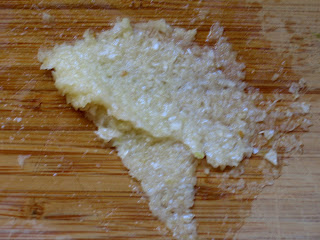
This is what the insides look like.

After scooping out the seeds, I used a big, sharp knife to cut the squash into 1 inch cubes. One of the wonderful things about kabochas is that you don't have to peel them. The skin is quite tender once it's cooked.

Next, I tossed it with olive oil and a generous pinch of salt. Ordinarily I would add a ton of pepper too, but I was going to put the squash in some sushi rolls I was making, so I decided against it.

Next, I spread the cubes in a single layer on a foil-lined cookie sheet and roasted them for about half an hour at around 400 degrees. You are trying to achieve a soft consistency with some caramelization around the edges.

I had about half of the squash left over last night so I was thinking what I could make. I also had a store-bought ball of pizza dough, some goat cheese, and a handful of each parmesan and shredded mozzarella. Pizza seemed like the obvious choice, but since the ingredients I had were a little dry, I decided they'd be perfect for calzones. I also decided to use pesto instead of a red sauce.
I preheated the oven to 475. There are a couple of little-known secrets to homemade pizza with a good crust texture. The first is a very high temperature. Trust me. The second is, if you don't have a pizza stone (which I don't) and are using a cookie sheet, let it preheat in the oven. This will help brown the bottom of the pizza or calzone.
Then I took my premade pizza dough out of the fridge and laid it on a lightly floured surface to relax a bit. I like to make things from scratch, but pizza dough is one of the things I'm perfectly happy to buy premade. It's cheap, good, and saves a ton of work!


Then I started with the pesto. I made quite a small batch, since my basil plant needs to recover from the last time (it's looking a little bare). I threw a bunch of leaves into the food processor, a pinch of salt, 2 cloves of garlic, crushed, a handful of parmesan, a generous 1/2 teaspoon of pepper, and some olive oil. The amount of oil depends on how the texture is when you process it. If it's not moving well within the food processor, add a bit of oil. I'd wager I used about a 1/3 of a cup.

Next I cut the pizza dough into four pieces and put three of them aside. I rolled the first piece into a ball then started flattening it out. You can either roll it, pound it, or stretch it. It doesn't matter, as long as you don't futz with it too much or the gluten will go crazy and your dough will be so stretchy that it will bounce back no matter when shape you try to coax it into.

Once the dough was a flat round about the size of my hand with my fingers outstretched, I spread it with pesto, some squash, bits of goat cheese and a sprinkling of mozzarella. The pesto can go on the whole thing but the rest of the toppings should stick to one side. Also, leave a rim for the dough to stick together. Fold over one side and pinch the edges closed with a fork. You want a good seal so the filling doesn't leak out and burn to the cookie sheet. Place it on a sheet of foil.

Repeat with the other calzones. Now take the hot cookie sheet out of the hot oven and lift the foil with the calzones onto it. Get it back into the oven and bake. Mine took about 20 minutes. I also decided about halfway through that I wanted to sprinkle a bit of parmesan on top of the calzones.

Once the outside is slightly golden and the crust sounds a bit hollow when tapped, take them out of the oven.

Serve hot.









































